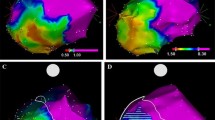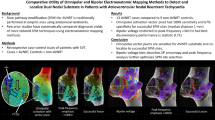Abstract
Background: The atrial activation sequence around the tricuspid annulus (TA) cannot always be used to establish whether complete block has been achieved across the cavotricuspid isthmus (CTI) during radiofrequency ablation (RFCA) for typical counterclockwise atrial flutter (CCW-AFL).
Aim: We examined whether a change in the polarity of the atrial high-density wide range-filtered bipolar electrograms recorded near the ablation line is an accurate indicator of complete CTI block.
Methods: Nineteen patients with CCW-AFL underwent RFCA. Electrograms were recorded around the TA with duodecapolar conventional (2mm × 8mm × 2mm spacing) and high-density (2-mm spacing) Halo catheters. The bipolar electrograms on the high-density Halo catheter recorded from a series of adjacent electrode pairs positioned just lateral to the ablation line were filtered at a bandpass setting of 0.05–500 Hz. The activation sequence on the conventional Halo catheter during coronary sinus pacing (CSp) and inferolateral TA pacing, and the bipolar electrograms on the high-density Halo catheter during CSp were determined before and after RFCA. The final complete CTI block was verified by the presence of widely split double electrograms ≥100 msec along the ablation line.
Results: The final complete CTI block was achieved in all the 19 patients. Before RFCA, the polarity of bipolar electrograms was predominantly negative during CCW-AFL and positive during CSp. In 18 of the 19 patients, the bipolar electrograms exhibited the CCW activation and a negative polarity during CSp only after complete CTI block. In one of those 18 patients, additional applications of RFCA changed the polarity of bipolar electrograms positive to negative although the conventional Halo electrogram activation sequence suggested complete CTI block during CSp. In seven patients, who had transverse conduction across the crista terminalis during CSp, the conventional Halo electrogram activation sequence suggested an incomplete CTI block. However, in six of those seven patients, the CCW activation had a predominantly negative polarity of the bipolar electrograms. In one of those seven patients, complete CTI block was unable to be detected even using the high-density Halo catheter.
Conclusions: These data demonstrate that the high-density wide range-filtered mapping can identify the CTI block in undetectable cases of complete CTI block or incomplete CTI block by the conventional method. The polarity of the bipolar electrograms recorded just lateral to the ablation line during CSp after RFCA of AFL may be used as a simple and an accurate indicator of complete CTI block.
Similar content being viewed by others
References
Cosio FG, Lopez-Gil M, Goicolea A, Arribas F, Barroso JL. Radiofrequency ablation of the inferior vena cava-tricuspid valve isthmus in common atrial flutter. Am J Cardiol 1993;71:705–709.
Feld GK, Fleck RP, Chen PS, Boyce K, Bahnson TD, Stein JB, Calisi CM, Ibarra M. Radiofrequency catheter ablation for the treatment of human type 1 atrial flutter. Identification of a critical zone in the reentrant circuit by endocardial mapping techniques. Circulation 1992;86:1233–1240.
Lesh MD, Van Hare GF, Epstein LM, Fitzpatrick AP, Scheinman MM, Lee RJ, Kwasman MA, Grogin HR, Griffin JC. Radiofrequency catheter ablation of atrial arrhythmias. Results and mechanisms. Circulation 1994;89:1074–1089.
Fischer B, Haissaguerre M, Garrigues S, Poquet F, Gencel L, Clementy J, Marcus FI. Radiofrequency catheter ablation of common atrial flutter in 80 patients. J Am Coll Cardiol 1995;25:1365–1372.
Blanck Z, Cetta T, Sra J, Jazayeri R, Dhala A, Deshpande S, Akhtar M. Catheter ablation of atrial flutter using radiofrequency current: Cumulative experience in 61 patients. WMJ 1998;97:43–48.
Calkins H, Leon AR, Deam AG, Kalbfleisch SJ, Langberg JJ, Morady F. Catheter ablation of atrial flutter using radiofrequency energy. Am J Cardiol 1994;73:353–356.
Nakagawa H, Lazzara R, Khastgir T, Beckman KJ, McClelland JH, Imai S, Pitha JV, Becker AE, Arruda M, Gonzalez MD, Widman LE, Rome M, Neuhauser J, Wang X, Calame JD, Goudeau MD, Jackman WM. Role of the tricuspid annulus and the eustachian valve/ridge on atrial flutter. Relevance to catheter ablation for the septal isthmus and a new technique for rapid identification of ablation success. Circulation 1996;94:407–424.
Schwartzman D, Callans DJ, Gottlieb CD, Dillon SM, Movsowitz C, Marchlinski FE. Conduction block in the inferior vena caval-tricuspid valve isthmus: Association with outcome of radiofrequency ablation of type 1 atrial flutter. J Am Coll Cardiol 1996;28:1519–1531.
Poty H, Saoudi N, Nair M, Anselme F, Letac B. Radiofrequency catheter ablation of atrial flutter. Further insights into the various types of isthmus block: Application to ablation during sinus rhythm. Circulation 1996;94:3204–3213.
Cauchemez B, Haissaguerre M, Fischer B, Thomas O, Clementy J, Coumel P. Electrophysiological effects of catheter ablation of inferior vena cava-tricuspid annulus isthmus in common atrial flutter. Circulation 1996;93:284–294.
Anselme F, Savoure A, Ouali S, Cribier A, Saoudi N. Transcristal conduction during isthmus ablation of typical atrial flutter: Influence on success criteria. J Cardiovasc Electrophysiol 2004;15:184–189.
Villacastin J, Almendral J, Arenal A, Castellano NP, Gonzalez S, Ortiz M, Garcia J, Vallbona B, Moreno J, Portales JF, Torrecilla EG. Usefulness of unipolar electrograms to detect isthmus block after radiofrequency ablation of typical atrial flutter. Circulation 2000;102:3080–3085.
Shah DC, Takahashi A, Jais P, Hocini M, Clementy J, Haissaguerre M. Local electrogram-based criteria of cavotricuspid isthmus block. J Cardiovasc Electrophysiol 1999;10:662–669.
Tada H, Oral H, Sticherling C, Chough SP, Baker RL, Wasmer K, Pelosi F Jr, Knight BP, Strickberger SA, Morady F. Double potentials along the ablation line as a guide to radiofrequency ablation of typical atrial flutter. J Am Coll Cardiol 2001;38:750–755.
Anselme F, Savoure A, Cribier A, Saoudi N. Catheter ablation of typical atrial flutter: A randomized comparison of 2 methods for determining complete bidirectional isthmus block. Circulation 2001;103:1434–1439.
Lin YJ, Tai CT, Huang JL, Liu TY, Lee PC, Ting CT, Chen SA. Characteristics of virtual unipolar electrograms for detecting isthmus block during radiofrequency ablation of typical atrial flutter. J Am Coll Cardiol 2004;43:2300–2304.
Tai, CT, Haque A, Lin YK, Tsao HM, Ding YA, Chen SA. Double potential interval and transisthmus conduction time for prediction of cavotricuspid ishmus block after ablation of typical atrial flutter. J Interv Card Electrophysiol. 2002;7:77–82.
Yamabe H, Okumura K, Misumi I, Fukushima H, Ueno K, Kimura Y, Hokamura Y. Role of bipolar electrogram polarity mapping in localizing recurrent conduction in the isthmus early and late after ablation of atrial flutter. J Am Coll Cardiol 1999;33:39–45.
Andronache M, de Chillou C, Miljoen H, Magnin-Poull I, Messier M, Dotto P, Beurrier D, Doan T, Houriez P, Bineau-Jorisse A, Thiel B, Brembilla-Perrot B, Massing JL, Sadoul N, Aliot E. Correlation between electrogram morphology and standard criteria to validate bidirectional cavotricuspid block in common atrial flutter ablation. Europace 2003;5:335–341.
Tada H, Oral H, Sticherling C, Chough SP, Baker RL, Wasmer K, Kim MH, Pelosi F Jr, Michaud GF, Knight BP, Strickberger SA, Morady F. Electrogram polarity and cavotricuspid isthmus block during ablation of typical atrial flutter. J Cardiovasc Electrophysiol 2001;12:393–399.
Oral H, Sticherling C, Tada H, Chough SP, Baker RL, Wasmer K, Pelosi F Jr, Knight BP, Morady F, Strickberger SA. Role of transisthmus conduction intervals in predicting bidirectional block after ablation of typical atrial flutter. J Cardiovasc Electrophysiol 2001;12:169–174.
Wijetunga M, Gonzaga A, Strickberger SA. Ablation of isthmus dependent atrial flutter: When to call for the next patient. Pacing Clin Electrophysiol 2004;27:1428–1436.
Chen J, de Chillou C, Basiouny T, Sadoul N, Filho JD, Magnin-Poull I, Messier M, Aliot E. Cavotricuspid isthmus mapping to assess bidirectional block during common atrial flutter radiofrequency ablation. Circulation 1999;100:2507–2513.
Shah D, Haissaguerre M, Takahashi A, Jais P, Hocini M, Clementy J. Differential pacing for distinguishing block from persistent conduction through an ablation line. Circulation 2000;102:1517–1522.
Sugimura H, Watanabe I, Okumura Y, Ohkubo K, Ashino S, Nakai T, Kasamaki Y, Saito S. Differential pacing for distinguishing slow conduction from complete conduction block of the tricuspid-inferior vena cava isthmus after radiofrequency ablation for atrial flutter-Role of transverse conduction through the crista terminalis. J Interv Card Electrophysiol 2005;13:125–134.
Sra J, Bhatia A, Dhala A, Blanck Z, Rathod S, Boveja B, Deshpande S, Cooley R, Akhtar M. Electroanatomic mapping to identify breakthrough sites in recurrent typical human flutter. Pacing Clin Electrophysiol 2000;23:1479–1492.
Zhang S, Younis G, Hariharan R, Ho J, Yang Y, Ip J, Thakur RK, Seger J, Scheinman MM, Cheng J. Lower loop reentry as a mechanism of clockwise right atrial flutter. Circulation 2004;109:1630–1635.
Author information
Authors and Affiliations
Corresponding author
Rights and permissions
About this article
Cite this article
Okumura, Y., Watanabe, I., Yamada, T. et al. Usefulness of the polarity in high-density wide range-filtered bipolar mapping to detect isthmus block during radiofrequency ablation of typical atrial flutter. J Interv Card Electrophysiol 15, 93–102 (2006). https://doi.org/10.1007/s10840-006-7659-y
Received:
Accepted:
Issue Date:
DOI: https://doi.org/10.1007/s10840-006-7659-y




